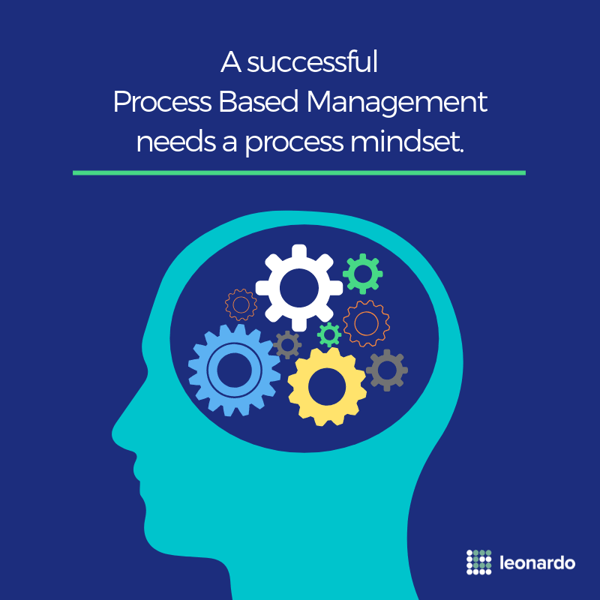-6565.png?width=1024&name=2019%20Blog%20Images%20(3)-6565.png)
Every quarter, the team at Leonardo Brisbane take part in the Brisbane BPM Roundtable – a group for like-minded BPM practitioners to network and wrestle with the big questions of process management. At the recent roundtable meeting, we talked ‘process mindset’, and asked people what their biggest challenge was when it came to implementing mindset at their organisation.
What is Process Mindset
To ‘do process’, an organization, and its people and their teams, need to ‘think process’.
In a process centric organization employees are conscious of their roles in the execution of a range of processes. They think beyond the activities described in their own job description to see their role in the bigger picture of creating, accumulating, and delivering value to customers and other stakeholders. The unrelenting emphasis is on conscious, proactive, cross-functional collaboration—and that is often different and challenging for individuals and functional units in an organization.
Tools and techniques are critically important, but they are not the main game. Having the right IT and other tools is necessary, but nowhere near sufficient, for success. Tools and techniques alone won’t create a viral spread of the idea of BPM. Hearts and minds are also needed.

Figure 1: Process Mindset
Challenge 1 – Natural human resistance that the majority businesses have on top of busy BAU
Many organisations share the situation of not having enough capacity to look at how to create more capacity. What tends to be successful is to start small and simple. Simple ideas that make the day-to-day a little easier are easy to implement and will have a positive result.
A local government department was in this very same position – they have now increased capacity and can process more than ever before, while taking on more and more challenges.
People with a ‘process’ mindset think beyond their jobs and what they do. By thinking of the day-to-day job in a different manner, improvements can slowly be identified and implemented. The improvements can increase capacity (and other dimensions around service, etc.), which, in turn, can be invested into more process knowledge, more improvements, and more radical change. Not every unit or organisation has the luxury of having dedicated process improvement people; but the above-mentioned government department didn’t either – it was not required. Albert Einstein warned us: “We cannot solve our problems with the same thinking we used when we created them.”
Here’s a simple example. When driving to work, do you take the same route every day, or do you try work out the quickest way to get there? Do you try new routes, think about alternative transport options, or listen to the traffic reports? These are all done while going to work, before work, during work, and after work. Some are implemented and some succeed, others don’t; but it is an ongoing activity.
Similarly, while you are working, you can ask yourself, “How can I work better, easier, and quicker?”
Challenge 2 – The functional view of the organisation vs. the end-to-end view of process
Process encourages one to think beyond the boundaries of their role, their job, and their department. It encourages people to look at the cross-functional processes and the contribution they make to the customer (stakeholders). Understanding how information, tasks, and products move through various functional units will help make a stronger case for change than simply looking at role of just one of them. This inspires conscious, proactive, and cross-functional collaboration, which can vary for different people and areas within an organisation.
There have been many studies and cases that prove, beyond a doubt, that an end-to-end process view is superior to a functional view – especially when it comes to improving process flows and lifting the focus on the client. This is not to say, though, there is not a time and space for a functional view.
Challenge 3 – People don't think that process is important.
This is often the case for people who either don’t understand ‘process’ and what it can do, or see process as a bunch of models, measures and architectures, which, by themselves, do not uplift organisational performance. Too often, companies embark on huge modelling efforts, but once the models are done, do not know what to do with them. Process mindset is not about the modelling, the tools, or the measures – it is about how one thinks about the work and the environment. The rest (change, modelling, improvement, etc.) will follow.
Unfortunately, the bad experiences people have witnessed makes them wary or mistrusting of the promises of process. However, to believe process doesn’t add value would be to belie what has been achieved across the world to date. There are those who think a process is a clever or fancy way of describing what a business does – but there is so much more to it than simply ‘understanding’ what is done. Just the act of running a simple modelling exercise will often highlight little improvements, or areas which don’t make sense.
A first step could be to make staff realise that everything they do is a process, regardless of whether they like it or not. Using everyday examples – visualise how there must be several activities and people involved to create something of value for internal/external customers. Based on this fundamental understanding, more initiatives such as process modelling / process improvement can begin. It is critical that people see they are part of a ‘big picture’, otherwise they will not see the value in anything process-related.
Challenge 4 – Change the culture for those not willing to let go old practises and procedures
Many people do not like change; they like security and comfort zones, and the fact that there are so many published methods on change management is evidence of this. People getting married, moving house, changing jobs often experience an element of nervousness and uncertainty mixed with excitement.
Therefore, shifting the culture will never be easy. A key thing to understand is that people move, or change, at different speeds when accepting the new. People generally want to know ‘what is in it’ for them. There are those who may have seen something like this before and it didn’t work, which will make them sceptical.
Changing the mindset is a step toward changing the culture. It is best to let people experience and learn for themselves rather than forcing it on them. Let them experience the rewards of making a change to improve things. Did anyone force us to use mobile phones? No. They were adopted because people saw the value in them, and this happened at a pace that suited the individual.
The value/benefit of everything process-related must be clearly demonstrated and articulated to those involved. Start small, grow big. Key influencers can be identified, their buy-in sought and then used to build support within teams, departments, and organisations. This is the most complicated tactic to achieve by far – hence, the whole discipline of change management was created.
Challenge 5 – Establishing what business process is
Address people’s perspectives and views about what ‘business process’ actually is. A lot of baggage comes with the term 'process' – resetting that and removing negative views on what it is or isn't can be difficult. Undoing ‘history’ is difficult. Unfortunately, people are not like computers, which you can reset, re-format, and re-load new software.
Even those of us within the BPM discipline struggle with a common definition for what ‘a process’ is. However, more important than having a clear definition is to use everyday examples from the organisation in scope to visualise which business processes are in use. This might include claiming travel expenses to on-boarding a new employee for a specific business process that stakeholders execute daily.
A good starting point is to focus on what ‘makes’ a process: the different people involved; the handover of work; the value created for a customer. While walking through these examples, staff will likely identify many areas within the business that need attention. That can, in turn, be used to identify key pain points, and why there is so much resistance to talking about business processes. Then, one can move the focus away from business processes in general, to specific root-causes (why is this process performing badly?), or begin talking about different, well-performing processes to remove negative biases.




